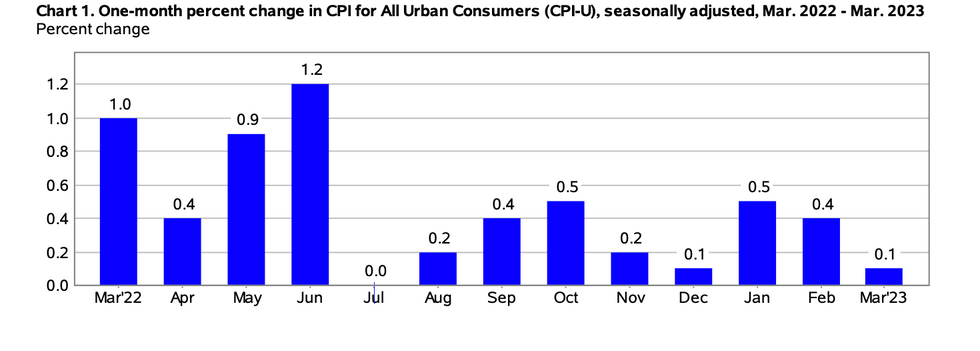Economy
12 April 2023
Inflation cooled to 5% in March, the slowest increase since May 2021
But food and rent prices remained elevated, the Consumer Price Index showed

But food and rent prices remained elevated, the Consumer Price Index showed

Inflation’s cooldown accelerated in March, even as food and rent prices remained high.
The Consumer Price Index from the U.S. Bureau of Labor Statistics showed the following for March 2023:
Year-over-year, inflation increased 5%. That’s down significantly from a 6% increase in February. It's the lowest rate since May 2021.
Month–over-month, inflation was up 0.1%, which is also a slowdown from 0.4% in February.
Core inflation, which leaves aside the volatile food and energy categories, increased 5.6% year-over-year.
Food at home, which includes groceries, saw a 0.3% decrease on the month. That was the first time this measure fell since September 2020. Year-over-year, food at home rose 8.4% over the last 12 months, paced by a 13.6% increase in cereals and bakery products.
Shelter, which includes rent, continued to be the primary driver of inflation, as the 8.2% year-over-year increase in this category accounted for 60% of core inflation.
Inflation in other key consumer goods categories, as measured on a year-over-year basis, includes:

What does this mean for the consumer economy? The inflation report comes after the Federal Reserve has undergone a monthslong campaign to raise interest rates as it seeks to bring prices down. The Fed’s goal is to bring inflation down to 2%. The report suggests the job is not done yet, but is nevertheless a sign that the increase in prices is slowing more significantly than in recent months.
But there's a tradeoff. The Fed’s aggressive moves to bring down prices also cool the economy as a whole. Combined with Friday’s jobs report that showed the smallest gain in new jobs since December 2020, there appears to be mounting evidence that the impact of the rate increases is taking hold. The question remains as to whether they will take a toll on households – and consumer demand– in the process of bringing prices down.
The report will be taken as good news, but it’s worth remembering that inflation continues to have an impact on households. While price increases are decelerating, the cost of essentials like food, gas, and rent is still high. That means “inflationary behaviors are still prevalent among Americans,” notes GlobalData Managing Director Neil Saunders.
“Along with inflation, households are feeling the impact of higher interest rates which are designed to cool prices but are pushing up variable mortgage rates and increasing interest on credit card and other debts,” Saunders said. “This means consumers are currently in the worst of both worlds, with both prices and debt servicing costs rising. The hope is that one of these issues, inflation, resolves itself over the course of this year – but it looks like this will only happen very gradually, meaning the household squeeze will continue for some time to come.”
Campbell Soup Company CEO Mark Clouse offered thoughts on messaging amid inflationary shifts in consumer behavior.
After months of elevated inflation and interest rate hikes that have the potential to cool demand, consumers are showing more signs of shifting behavior.
It’s showing up in retail sales data, but there’s also evidence in the observations of the brands responsible for grocery store staples.
The latest example came this week from Campbell Soup Company. CEO Mark Clouse told analysts that the consumer continues to be “resilient” despite continued price increases on food, but found that “consumers are beginning to feel that pressure” as time goes on.
This shows up in the categories they are buying. Overall, Clouse said Campbell sees a shift toward shelf-stable items, and away from more expensive prepared foods.
There is also change in when they make purchases. People are buying more at the beginning of the month. That’s because they are stretching paychecks as long as possible.
These shifts change how the company is communicating with consumers.
Clouse said the changes in behavior are an opportunity to “focus on value within our messaging without necessarily having to chase pricing all the way down.”
“No question that it's important that we protect affordability and that we make that relevant in the categories that we're in," Clouse said. "But I also think there's a lot of ways to frame value in different ways, right?”
A meal cooked with condensed soup may be cheaper than picking up a frozen item or ordering out. Consumers just need a reminder. Even within Campbell’s own portfolio, the company can elevate brands that have more value now, even if they may not always get the limelight.
The open question is whether the shift in behavior will begin to show up in the results of the companies that have raised prices. Campbell’s overall net sales grew 5% for the quarter ended April 30, while gross profit margins held steady around 30%. But the category-level results were more uneven. U.S. soup sales declined 11%, though the company said that was owed to comparisons with the quarter when supply chains reopened a year ago and expressed confidence that the category is seeing a longer-term resurgence as more people cook at home following the pandemic. Snacks, which includes Goldfish and Pepperidge Farm, were up 12% And while net sales increased overall, the amount of products people are buying is declining. Volumes were down 7%.
These are trends happening across the grocery store. Campbell is continuing to compete. It is leading with iconic brands, and a host of different ways to consume them. It is following that up with innovation that makes the products stand out. Then, it is driving home messaging that shows consumers how to fit the products into their lives, and even their tightening spending plans.
Campbell Soup is more than 150 years old, and has seen plenty of difficult economic environments. It is also a different business today, and will continue to evolve. At the end of the day, continued execution is what’s required.
“If it's good food, people are going to buy it, especially if it's a great value,” Clouse said.